
Happy July 14th!
Today for the first time since last Thursday, the forecast did not get more bearish.
The dome towards the end of 2 weeks starts moving back in the direction of the Midwest at least on the GFS products.
The EURO had just a small change in this direction and the CMC model has the complete opposite........it smashes the heat ridge down even more.
There will be a mega dome, moving around the next 2 weeks. It could expand north or east later this month.............and the models just don't realize it yet.(actually a few, minority solutions have this idea).
Despite this, there is a ton of rain on the way.......thought the Southwest Cornbelt will get short changed, with high heat causing conditions to deteriorate there.
+++++++++++++++++++++++++++++++++++++++++++++
Heat fill coming up for corn
Started by metmike - June 25, 2020, 7:52 p.m.
https://www.marketforum.com/forum/topic/54571/
July 3rd update: Early La Nina right now! My Summer Forecast/La Nina this Summer! Started by metmike - May 23, 2020, 11:33 p.m.
https://www.marketforum.com/forum/topic/52701/
Latest COVID-19 numbers. ...........going up.....but deaths(lagging indicator) have not increased yet. PROOF THAT PROTESTS ARE SIGNIFICANTLY INCREASING NEW CASES!
https://www.marketforum.com/forum/topic/55092/
Scroll down and enjoy the latest comprehensive weather to the max...... occurring because of the natural physical laws in our atmosphere as life on this greening planet continues to enjoy the best weather/climate in at least 1,000 years(the last time that it was this warm) with the added bonus of extra beneficial CO2.
Reasons to keep being thankful here in 2020!
https://www.marketforum.com/forum/topic/45623/
Go to the link below, then hit the location/county on the map for details.
https://www.spc.noaa.gov/ Go to "hazards"
Here are the latest hazards across the country.
 |
Purple/Pink/blue on land is cold/Winter weather. Brown is wind, Green is flooding. Gray is fog. Reddish is a red flag advisory.
Go to the link below, then hit the location/county on the map for details.
https://www.spc.noaa.gov/ Go to "hazards"
https://www.mesonet.org/index.php/weather/map/us_air_temperature/air_temperature

https://www.mesonet.org/index.php/weather/map/wind_chill_heat_index1/air_temperature

Current Weather Map
| NCEP Days 0-7 Forecast Loop | NCEP Short-Range Model Discussion | NCEP Day 3-7 Discussion |


Current Jet Stream

| Low Temperatures Tomorrow Morning |

Highs today and tomorrow.



Highs for days 3-7:
Triple digit heat in the S.Plains early in the period... Some of that heat spreads east/northeast THIS week(90's)!!!
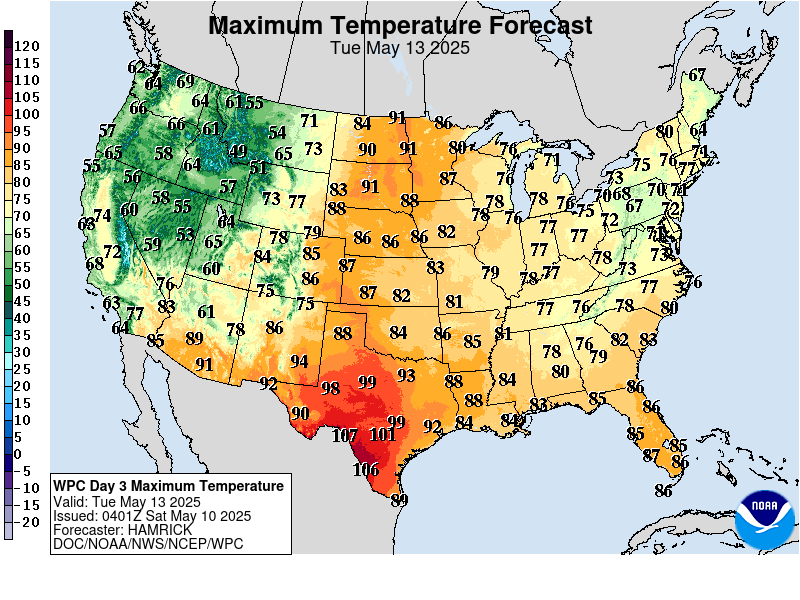
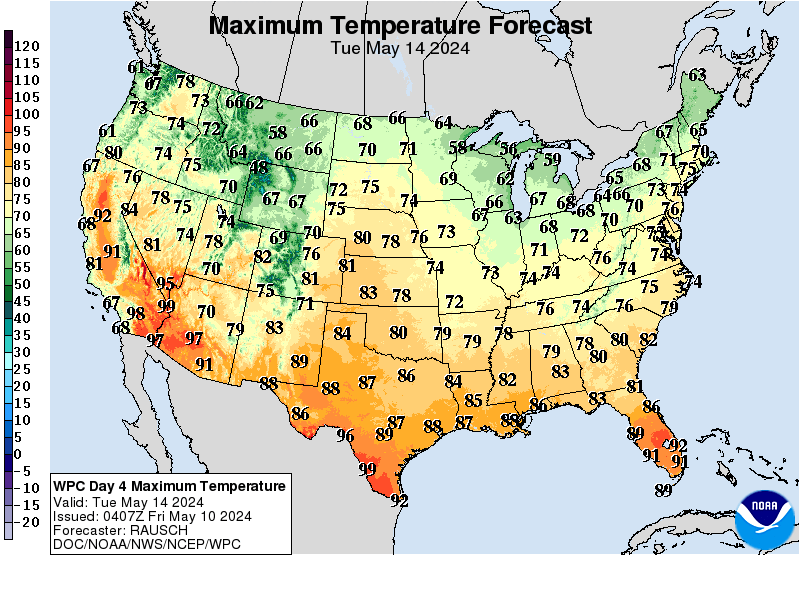
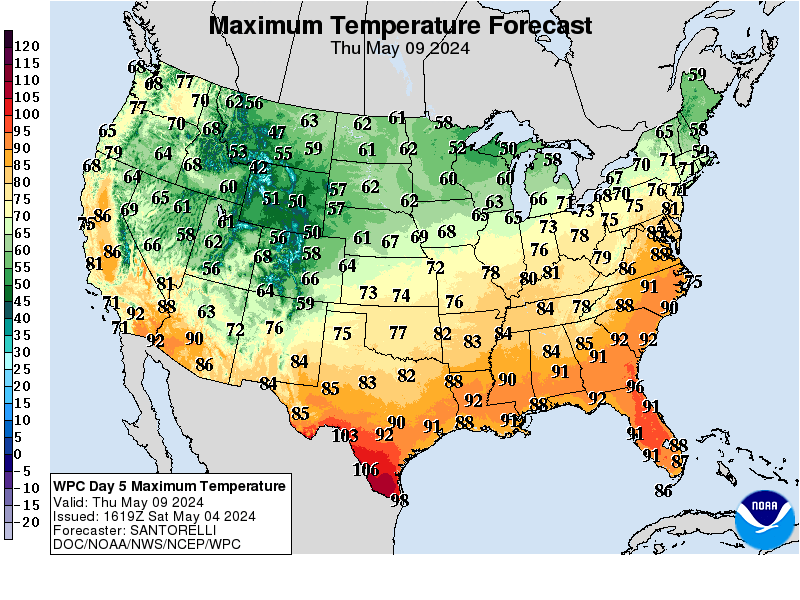
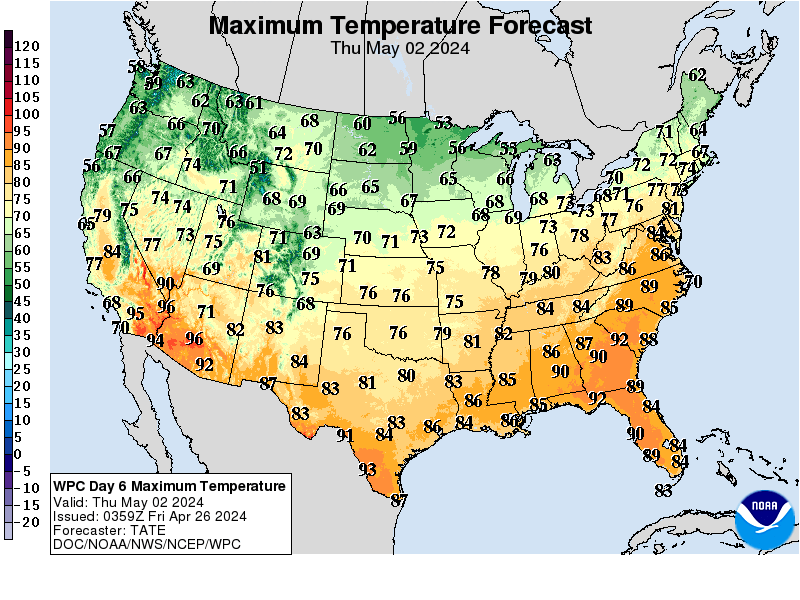
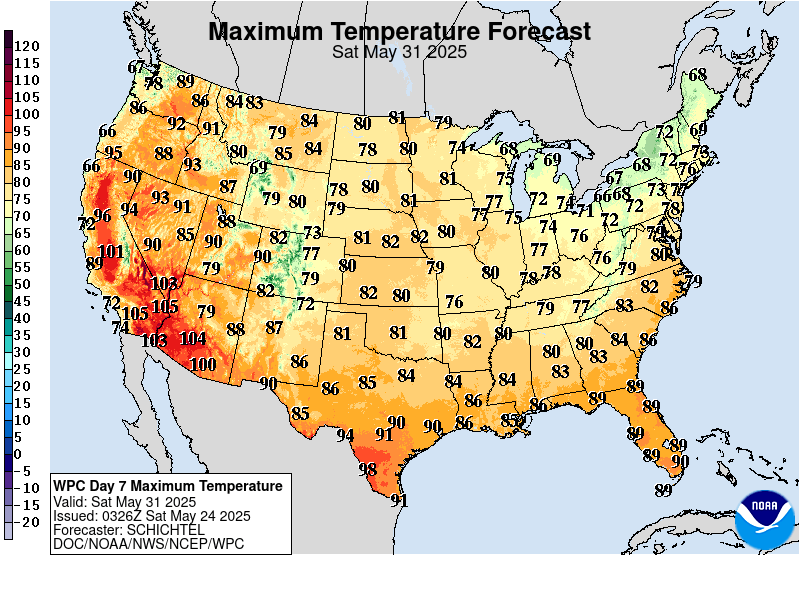
Temperatures compared to Average for days 3-7
The Southern Plains heat will be spreading east/northeast this week!
Considering that we are approaching the hottest time of year climatologically, these red departures above average are pretty impressive.
https://www.wpc.ncep.noaa.gov/medr/medr_mean.shtml
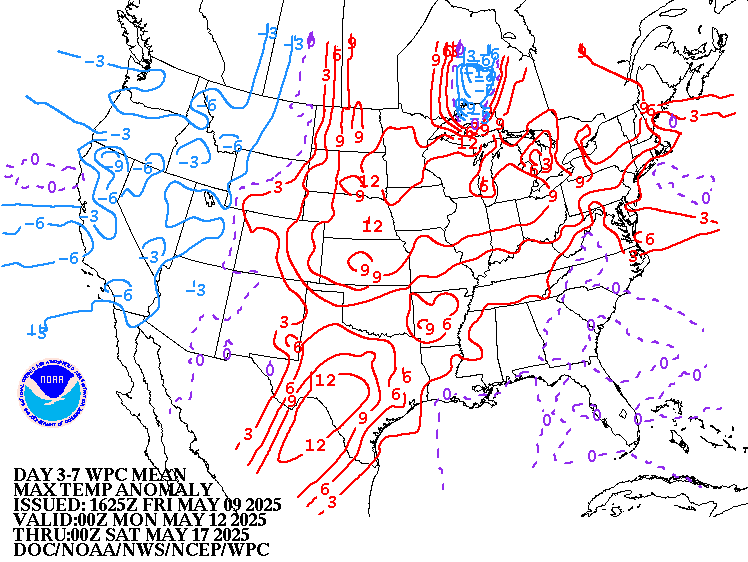
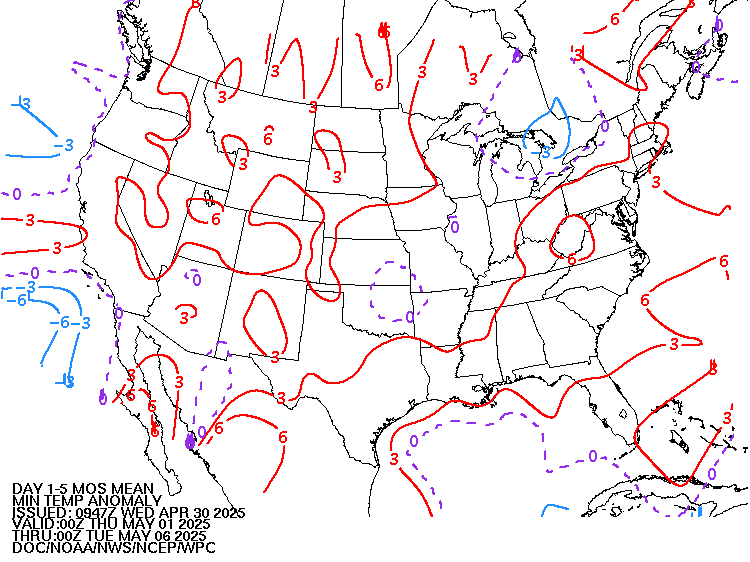
Surface Weather features day 3-7:
Cold front gets a good push thru the northern tier early this week, with decent rain chances there that move south by midweek, possibly down to the Ohio River by Thursday........... before moving back north a bit after that.
To it's south, warm air aloft will suppress vertical lift needed to generate rains. This from a major heat ridge/dome.
100+ Southern Plains, some of the heat(90's) spreads east this week.
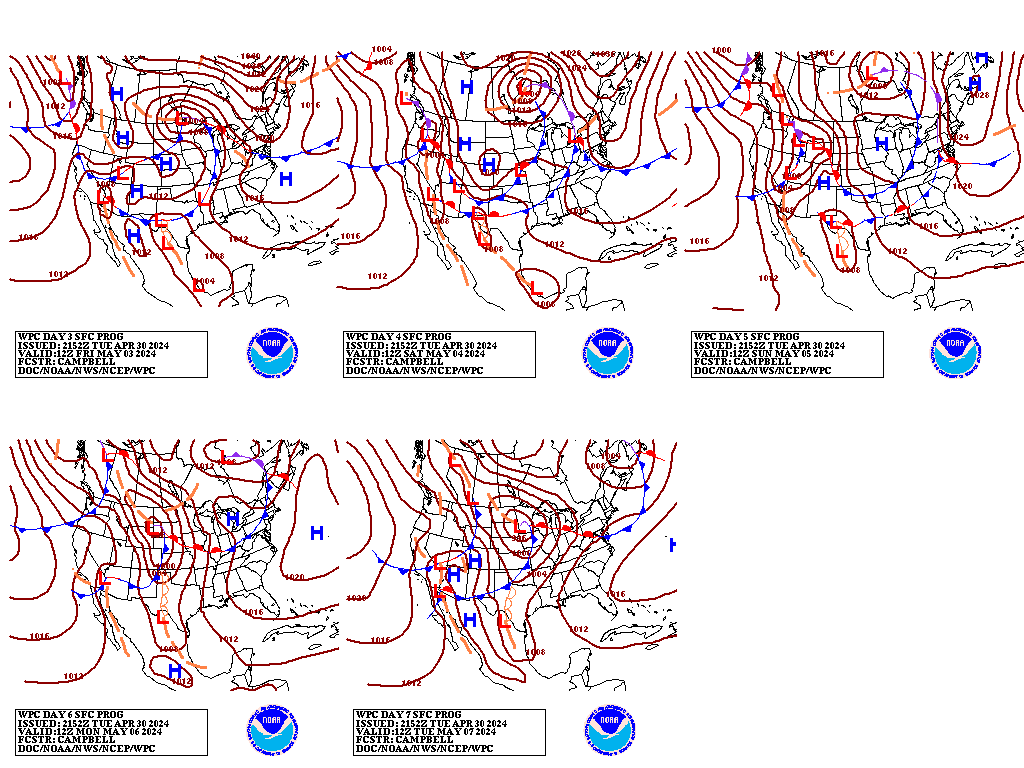
Liquid equivalent precip forecasts for the next 7 days are below.
Rains are shifting southeast now in tandem with a cold front that gets close to the Ohio River by Thursday. Loads of rain associated with the surface/synoptic feature.
Warm air aloft, associated with the S.Plains dome will defeat attempts for hot air at the surface to have enough ascent/lift/instability to generate rain. This warm air aloft will spread into the southwestern cornbelt and temporarily in the southern half of the Cornbelt over the weekend.
Day 1 below:
http://www.wpc.ncep.noaa.gov/qpf/fill_94qwbg.gif?1526306199054
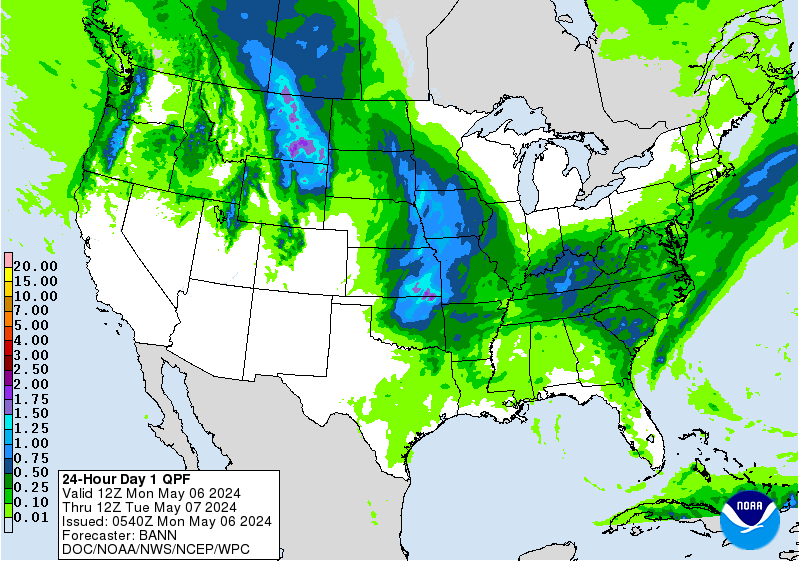
Day 2 below:
http://www.wpc.ncep.noaa.gov/qpf/fill_98qwbg.gif?1528293750112
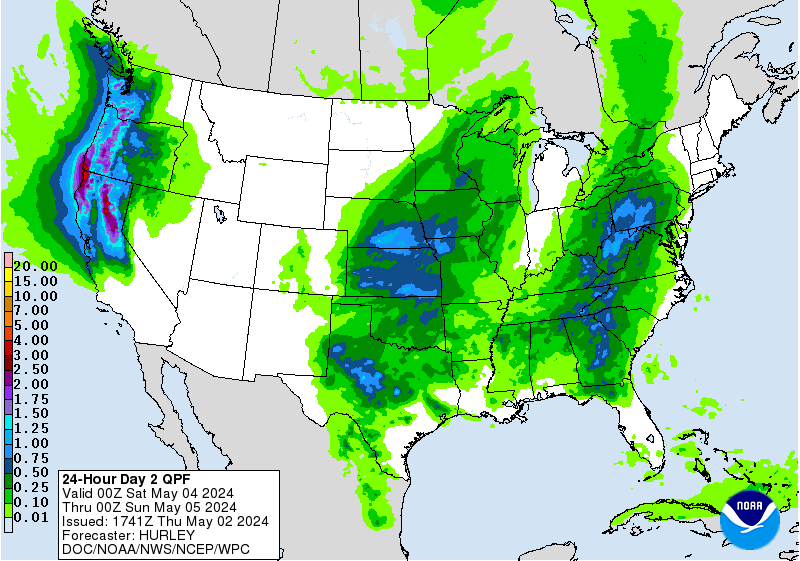
Day 3 below
http://www.wpc.ncep.noaa.gov/qpf/fill_99qwbg.gif?1528293842764
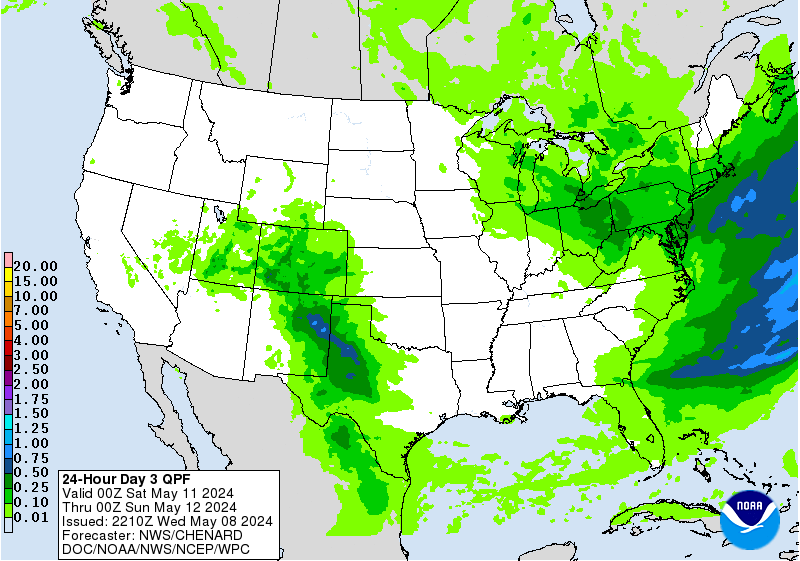
Days 4-5 below:
http://www.wpc.ncep.noaa.gov/qpf/95ep48iwbg_fill.gif?1526306162
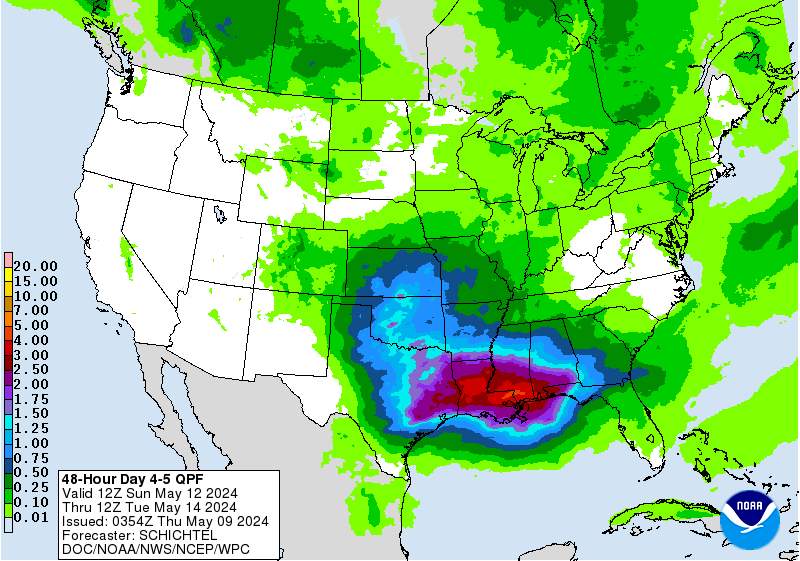
Days 6-7 below:
http://www.wpc.ncep.noaa.gov/qpf/97ep48iwbg_fill.gif?1526306162
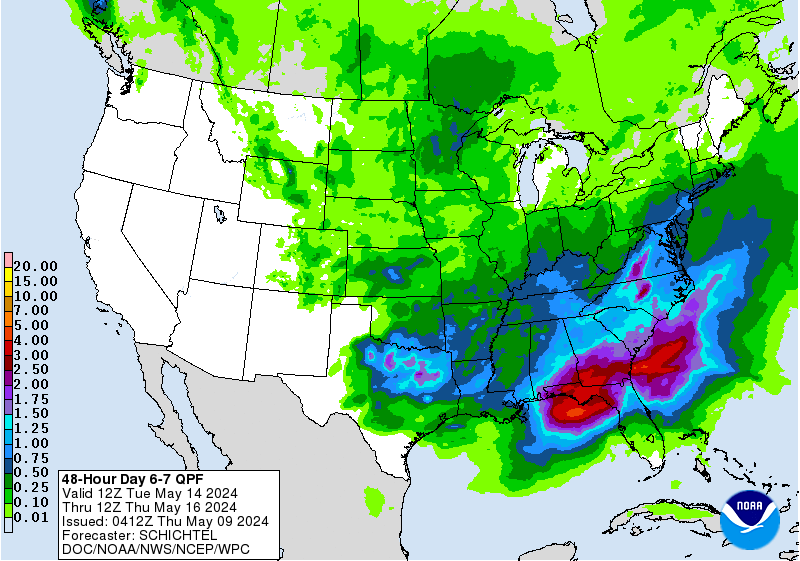
7 Day Total precipitation below:
https://www.wpc.ncep.noaa.gov/qpf/p168i.gif?1566925971
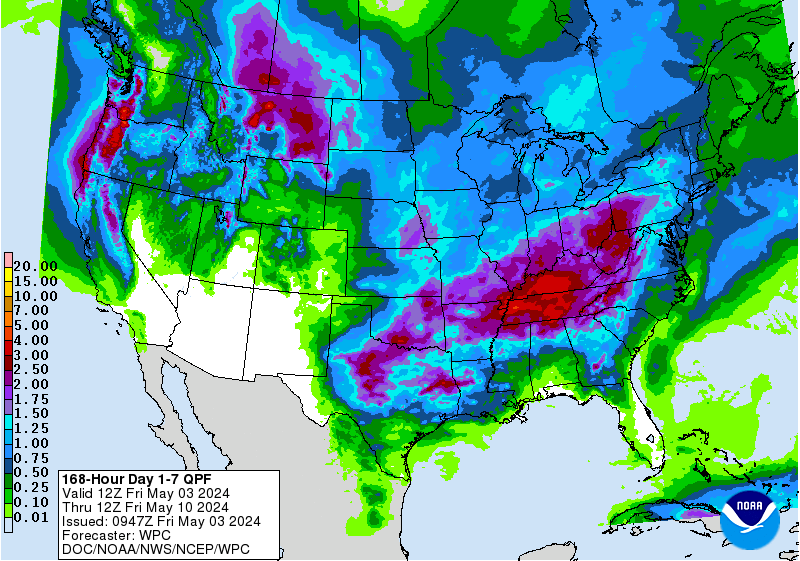
Excessive rain potential.
Mesoscale Precipitation Discussions
Current Day 1 Forecast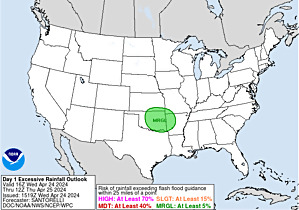 Valid 16Z 08/30/19 - 12Z 08/31/19 |
Day 1 Threat Area in Text Format
| Day 2 and Day 3 Forecasts |
Current Day 2 Forecast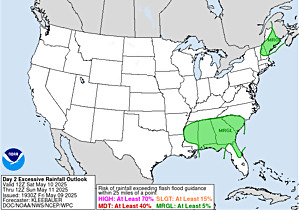 Valid 12Z 08/31/19 - 12Z 09/01/19 |
Day 2 Threat Area in Text Format
Current Day 3 Forecast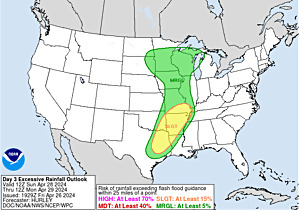 |
Blue triangles indicate a place where a 55+ mph wind occurred..
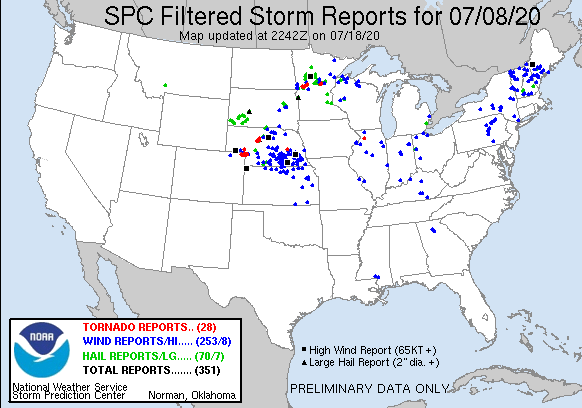
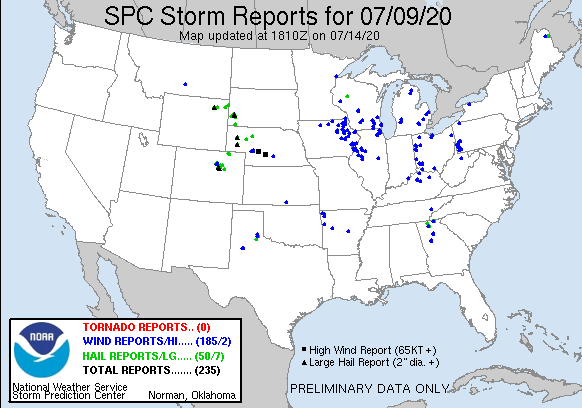
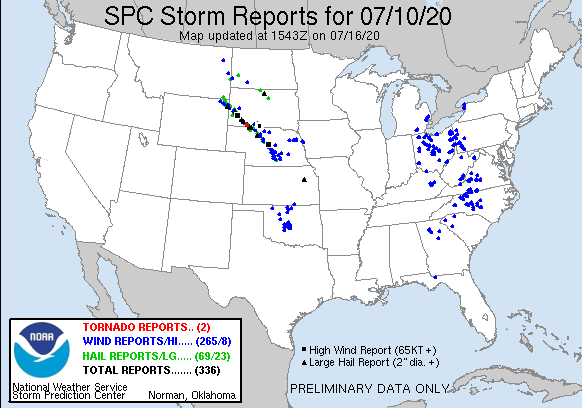
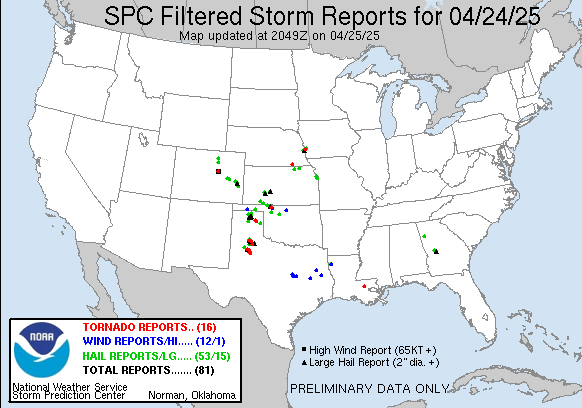
+++++++++++
Last 24 hour precip top map
Last 7 day precip below that
https://www.wunderground.com/maps/prec
Rains the previous 24 hours from those storms and rains the last 7 days from storms.

Learn About Daily Precipitation

Current Dew Points
Moisture returning north to meet the cold front.

Latest radar loop
http://www.nws.noaa.gov/radar_tab.php


| (3400x1700 pixels - 2.2mb) Go to: Most Recent Image |

Go to: Most Recent Image
You can go to this link to see precipitation totals from recent time periods:
https://water.weather.gov/precip/
Go to precipitation, then scroll down to pick a time frame. Hit states to get the borders to see locations better. Under products, you can hit "observed" or "Percent of Normal"
Soilmoisture anomaly:
These maps sometimes take a day to catch up to incorporate the latest data(the bottom map is only updated once a week).
https://www.cpc.ncep.noaa.gov/products/Soilmst_Monitoring/US/Soilmst/Soilmst.shtml#
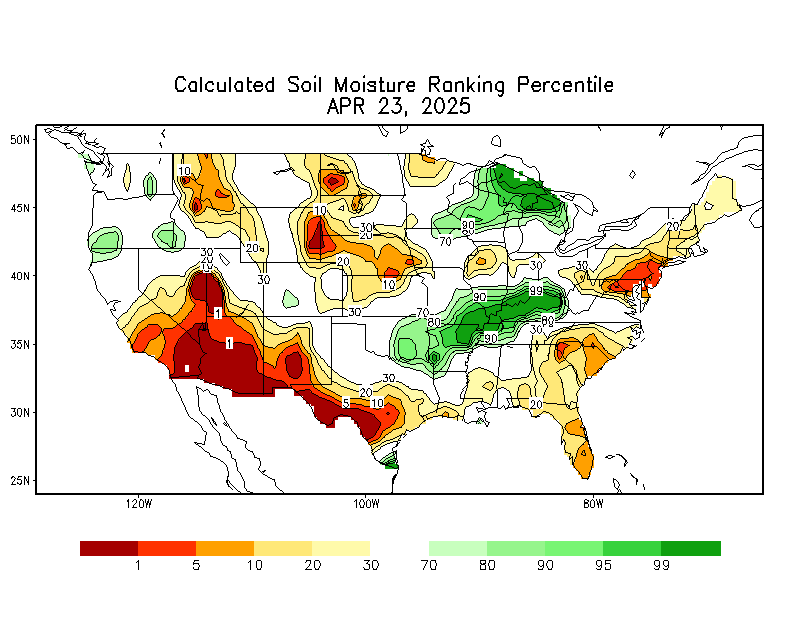
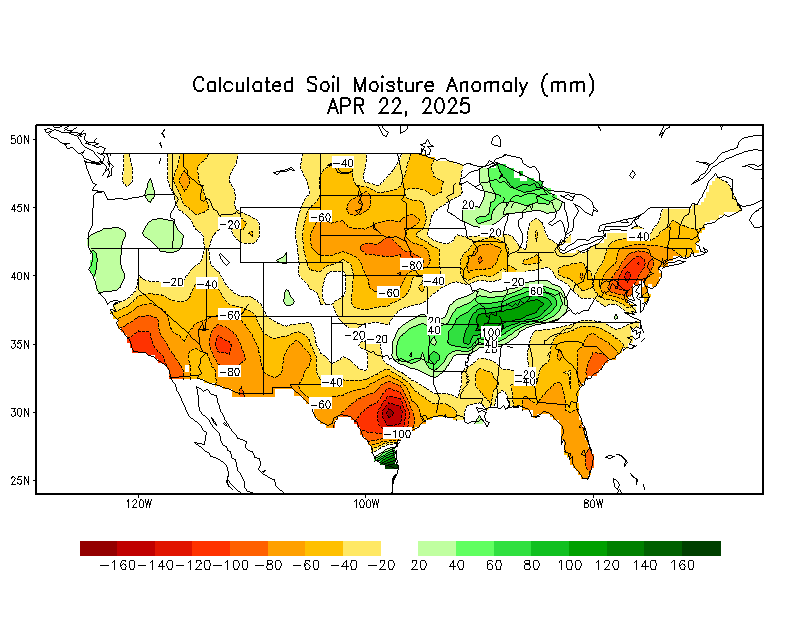
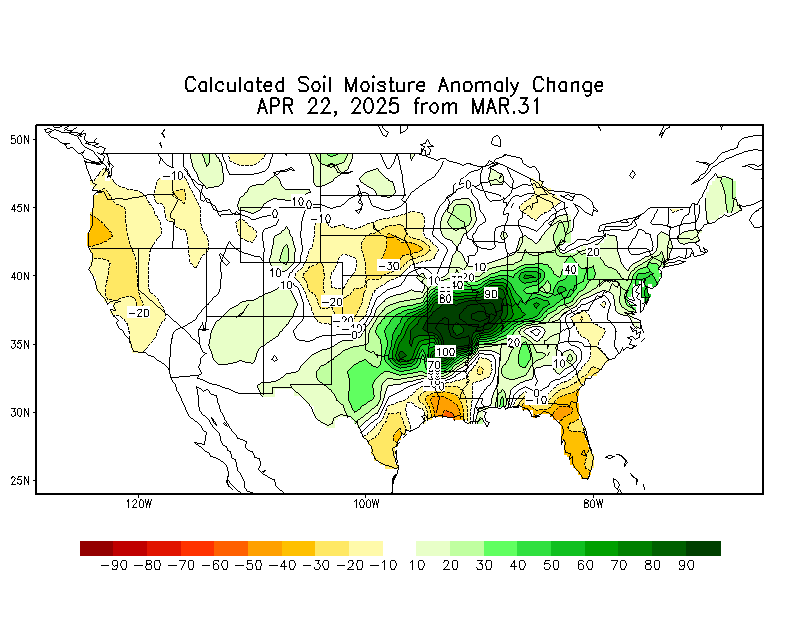
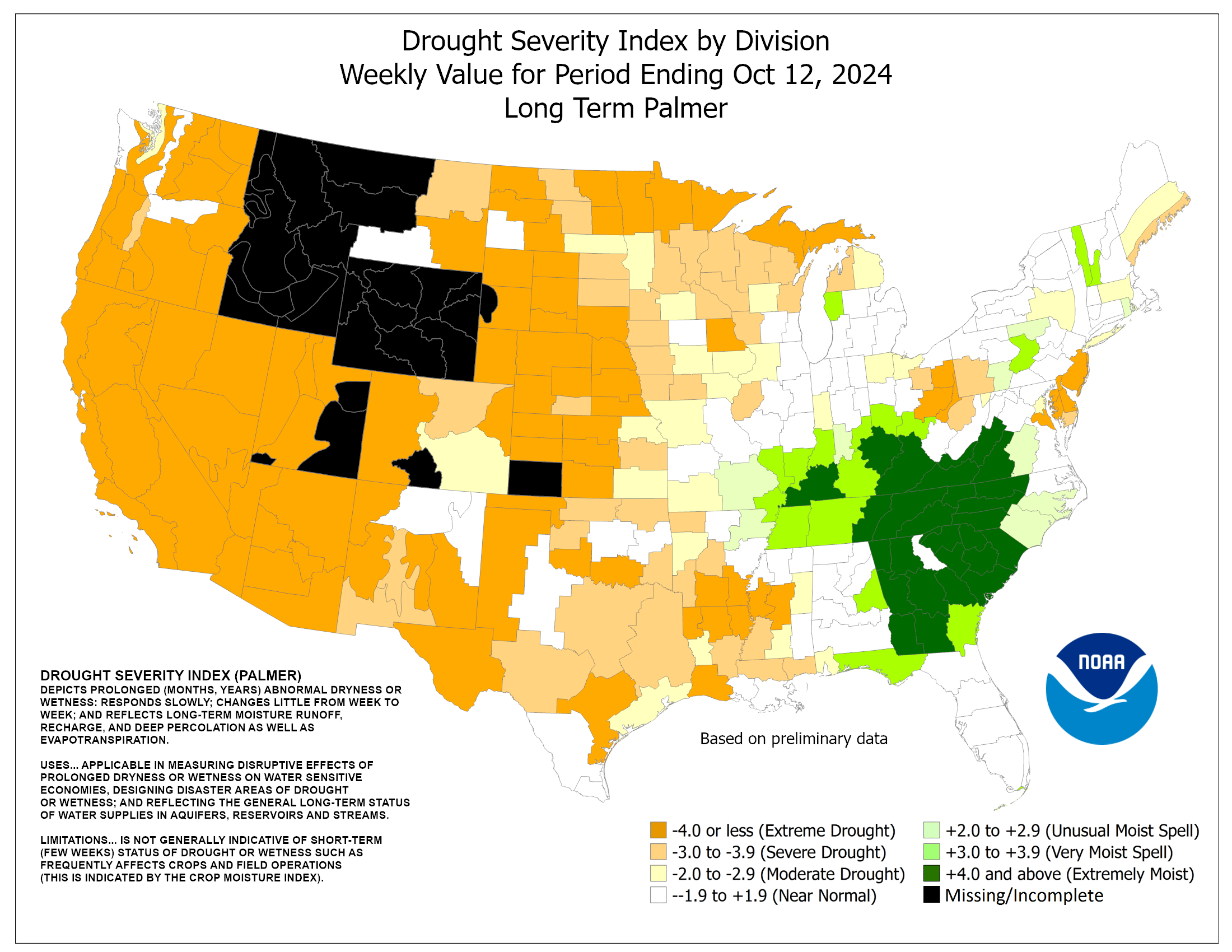
Drought Monitor maps:
Latest: The first map below is the latest. The 2nd one is from last week.
April 23: LOOKY_LOOKY! For the first time this year, its gotten dry enough for a few (small)areas in the Upper Midwest/Western Cornbelt to report slight drought.
April 30: Drought increased a bit......Plains and U.Midwest.
May: 7: Drought increased a bit from KS westward.
May 14: Drought increased a bit again, now, parts of Iowa have slight drought(this dry weather is why planting is ahead of schedule). Rains are coming to the dry spots in the forecast though.......bearish.
May 21: A bit more drought in ND.
May 28: Not much change
June 4: Drought increases a tad in the N.Plains and Upper Midwest.
June 10: Drought worsening in the S.Plains could be part of the La Nina signal!!
June 17: Drought got worse again in the S.Plains and yellows/slight drought emerged in new locations............all of Indiana.
June 24: Drought help in some places(KS) but increased a bit in others(ND).
July 1: Drought shrunk in Ohio Valley(I got 5.5 inches of rain in sw INdiana!) but not much change elsewhere. Surprised it didn't shrink more in IN/IL where some places(Bowyer) got great rains recently.
July 8: The main change was an increase over w.IA and e.NE. At the end of July with the hot/dry weather coming up, the S.Plains drought should expand into the S.Midwest to the Eastern Cornbelt.
The maps below are updated on Thursdays.
https://droughtmonitor.unl.edu/


The top map is the Canadian ensemble average, the maps below are the individual members that make up the average at the end of week 2.
+++++++++++++++++++++++++++++++++++++++++
Each member is like the parent, Canadian model operational model.......with a slight tweek/variation in parameters. Since we know the equations to represent the physics of the atmosphere in the models are not perfect, its useful to vary some of the equations that are uncertain(can make a difference) to see if it effects the outcome and how.
The average of all these variations(ensembles) often yields a better tool for forecasting. It's always more consistent. The individual operational model, like each individual ensemble member can vary greatly from run to run.........and represent an extreme end of the spectrum at times. The ensemble average of all the members, because it averages the extremes.............from opposite ends of the spectrum.........changes much less from run to run.
End of week 2....................0z Canadian ensembles:
Wednesday, June 24th: this model is the HOTTEST! 588 contour is now NORTH of Chicago and on day 16 we have our first 594 dm contour in Arkansas with the major heat ridge. A minority of solutions still disagree with this and the other models are not nearly this bullish but are leaning in this direction.
Thursday: Major heat ridge southern half, with strong agreement. Fast, active flow northern tier.This is a very warm to hot pattern for much of the country! How far south will rains go into the rain defeating heat ridge?
Friday: Not as bullish with the heat ridge at Noon Friday. Jet stream farther south. It will probably look different over the weekend.
Saturday. MUCH stronger with the heat ridge from the S.Rockies/Plains to points eastward.......some solutions have a "dome of death". Fast jet stream in the northern 1/3rd.
Sunday: Major dome with blistering heat and no rain, most likely centered in the S.Plains but other locations possible, especially with it being very expansive.
Monday/latest: Same as Sunday.............very impressive with widespread agreement!
Tuesday: Continues very impressive with the heat ridge in the Southern half of the country, especially the S.Plains. Several ......minority of members try to crash the top of the ridge in the Upper Midwest/N.Plains with energy towards the end of week 2. Regardless, there WILL BE widespread big heat across much of the country!
Wednesday: Still impressive dome, especially S.Plains but the top is eroded a bit on todays models.
Thursday: Most impressive display of the dome yet for this model. 588 decameter contour north of Chicago but look at the huge 594 contour in the S.Plains. Temps under that will be 100+. It's location could continue to shift north or east.......or back in the other direction if energy from the norther tier batters down the top of the ridge. Either way, there WILL be a major heat dome.
Friday: Possible cooling northern tier on this model. Heat ridge in the south.
Sunday: Massive heat ridge/dome............but the location is uncertain, especially how far east does it extend? Pretty strong jet stream just south of the Canadian border. Will that erode the ridge or send cold fronts south or will it define the strong boundary between the heat wave to the south with capped air under warm air aloft and the dome and active weather over the top/along the periphery of the heat ridge/dome?
Monday: Strong jet stream along the Canadian border, massive heat ridge south of that.
Wednesday: Very impressive dome/heat ridge that will defeat any rain making attempts because of warm air aloft under areas with a 594 dm height(centered in the S.Plains) and a bit north of that. Triple digit heat WILL be widespread under the dome.
Thursday: The ensemble average of all the solutions is less bullish than yesterday. It backs the dome up hundreds of miles and allows northwest flow to increase in the Midwest. However, there are still some individual solutions with a MEGA dome much farther east.
Friday: On this model, at the end of 2 weeks, the dome is STRONGER and BIGGER. Some solutions still have northwest flow into the Midwest, others have a mega dome across the southern 2/3rds of the country.
Saturday: A lot of uncertainty on where the for sure dome will be located. Not as hot.
Sunday: Where will the dome be in 2 weeks? S.Plains to S.Rockies?? Northwest flow Upper Midwest to Northeast???
Monday: Heat ridge weaker on the average but some individual solutions are still impressive. Most likely location is to shift a bit west from the S.Plains.
Tuesday: The Canadian model AVERAGE backs the ridge farther west with an active jet stream across the northern 1/3rd of the US. Several Individual solutions have the dome MUCH farther north and east.
360h GZ 500 forecast valid on Jul 29, 2020 00 UTC
Forecasts for the control (GEM 0) and the 20 ensemble members (global model not available)
Individual GFS ensemble solutions for the latest 0z run:
Saturday June 19th : Several members have a huge dome.............others northwest type flow in the Midwest to Northeast.
Sunday: Same disparity without many solutions having the center of the heat ridge in the Midwest. ...........where active flow/perturbations could trigger decent rains.
Tuesday: Active northwest flow in the Midwest on the majority of solutions for the GFS Ensemble. .....but several have the heat ridge stronger shoving the jet stream out, with more heat as a result.
Wednesday: Heat ridge Southwest to S.Plains on many solutions but still northwest flow over with perturbations and rain dropping from the N/C.Plains into the Midwest. Will the heat ridge continue to build and shove the jet stream and northwest flow farther north like the Canadian model? Or is the Canadian model out to lunch?
Thursday: Big heat ridge/dome but location is uncertain. S.Plains is a very good bet but also points northeast to east could have a heat ridge.
Friday: This model is MORE bullish with the idea of the heat ridge building northeast. It also will probably look different early next week.
Saturday: How far north will the dome/heat ridge be? Fast flow south of the Canadian border.
Sunday: Core of dome/heat ridge C/S Plains to Rockies but potentially very expansive.What often happens is that cold fronts that push thru, cut under the very warm air aloft from the dome(capped air) that has fed into parts of the Midwest and the front is unable to generate the rising air/instability needed to generate rain/storm bearing clouds.
Monday: Heat ridge/dome is farther west on this model than, especially the Canadian model but still very impressive.
Tuesday: Big heat ridge in the S.Plains. How far east/west and north is the big ??
How much jet stream along the northern tier can erode the top of the ridge? Or does it help to lock it in, just south with fast flow north of it.
Wednesday: Expected daily/model run fluctuations. In this case, the last couple of runs are suggesting the dome erodes and on the GFS, backs up to the west a bit. Pretty strong jet stream for July across the northern tier of states.
Thursday: This model is going back and forth. It was backing the dome farther southwest for a couple of solutions(cold front making it thru the Midwest), then the last one brought it the farthest northeast yet.
Friday: Unlike the Canadian model, the GFS has the heat ridge dominating farther north
Sunday: Massive heat ridge/dome over much of the country. Possible cooling Northeast and likely cooling Northwest.
Monday: Huge heat ridge for much of the country.
Wednesday: Dome is all over the place on different solutions but there WILL be a dome of rain suppressing, warm air aloft with near 100 degree heat at the surface.
Friday: Around half have northwest flow into the Midwest. Around half have a more impressive dome that keeps the rains in the Upper Midwest. Plenty of heat.
Saturday: Where will the massive dome be in 2 weeks?
Monday: Dome has continued to shift farther west the last couple of days. Active northwest flow in the Midwest should lead to abundant rains.
Tuesday: The backed up dome starts moving back northeast towards the end of 2 weeks..........according to this model. Still some active northwest flow into the Midwest ahead of that..with abundant rains.

GFS Ensemble mean(average of all the individual solutions above). The first map is a mid/upper level map. The 2nd one is a temperatures map at around 1 mile above the surface. These are anomalies(difference compared to average).
NCEP Ensemble t = 360 hour forecast
Saturday, June 20: We should note that major positive anomalies in June are heat ridges in the middle latitudes. They are really moving around right now with a transient type pattern. At day 7, a big one in Eastern Canada, another just off the Pac Northwest Coast. At day 14, in SouthCentral Canada to the N.Plains. The Gulf Coast is one of the few places with average to modestly negative anomalies. This suggests that the heat will be farther north. Though the models have lots of rain during this period, if we saw negative anomalies increase along the Gulf Coast, they could impede the deep moisture return northward and we would see a drier heat from the west vs air masses with more of a south to north component, loaded with juicy GOM moisture. The day 14 pattern is clearly very warm to hot(at times) for much of the country. Not as hot as yesterday but even air masses coming from S.Canada with any cold fronts will be warm and quite dry.
Tuesday: Strong Positive anomaly at the end of week 1 around the Hudson Bay means heat in S.Canada to just south of the border. It migrates west and weakens in SouthCentral Canada with a weak negative anomaly in the Southeast US which makes heat unlikely in the Southeast US if that verifies.
Wednesday: Positive anomaly center around the N.Great Lakes area makes heat in that area a given. It will be widespread from the N.Plains to the Northeast. Temperature in the Southeast will be closer to normal.
Thursday: End of week 2 positive anomaly will determine the extent and strength of a major heat ridge. S.Plains look most likely from weather models but the anomaly map is not that helpful.
Friday: Anomaly positive in week 2....on this model is pretty favorable for ridging in the S.Plains to extend northeast across the Midwest to the Northeast. Slight weakness Pac Northwest and Gulf Coast.
Saturday: Positive anomalies and widespread heat.
Sunday: Same as Saturday. There WILL be a big dome and the heat ridge will be very expansive. Location will be a key.
Monday/latest: Positive anomalies and widespread heat........similar to the last several days!
Tuesday: Positive anomaly northcentral USA associated with the big heat ridge just south of that location. Temperature anomalies will be greatest around the C/S Plains., with widespread 100+
Wednesday: Positive anomaly shifted a bit westward but dome still a dominate feature with widespread heat.
Thursday: This solution of this model shifts the center of the positive anomaly in the US a tad farther west into the Rockies. The solution 6 hours after this shifted it back eastward.............so its going back and forth.
Friday: Positive anomalies over almost the entire country. Centered in the NorthCentral US. Widespread heat!
Saturday: New slight negative anomaly in the Southeast at day 7 is associated with surprise cooling(less heat) for a few days in that area. This reverts back to widespread positive anomalies across the country in week 2, with the center in the NorthCentral US. Strong signal for widespread heat and a big heat ridge.
Monday: Weak negative anomaly day 7 with temporary cooling in the East. Then positive anomalies in week 2 take over the entire country with a center in the Great Lakes. Widespread heat-high confidence. As soils dry out, day time max temps will get higher.
Wednesday: At 2 weeks, most of the country is under positive anomalies with the maximum anomaly over the Great Lakes. Widespread heat.
Thursday: Positive anomalies and heat dominate much of the country in week 2 based on this product. How much rain around the periphery/(north) of the dome/heat ridge and where?
Friday: Waxing and waning dome, moving around? Late week 2 still features the center of the widespread positive anomalies in the NorthCentral US.,,,,,,even though the center of the actual dome should be farther south in the S.Plains. Widespread heat........in the hottest time of year.
Saturday: Plenty of heat but not as hot as Friday.
Tuesday: Positive anomaly center slight farther east today vs yesterday.....on the GFS. Is the dome going to shift back east again? Widespread heat.
1 week out below
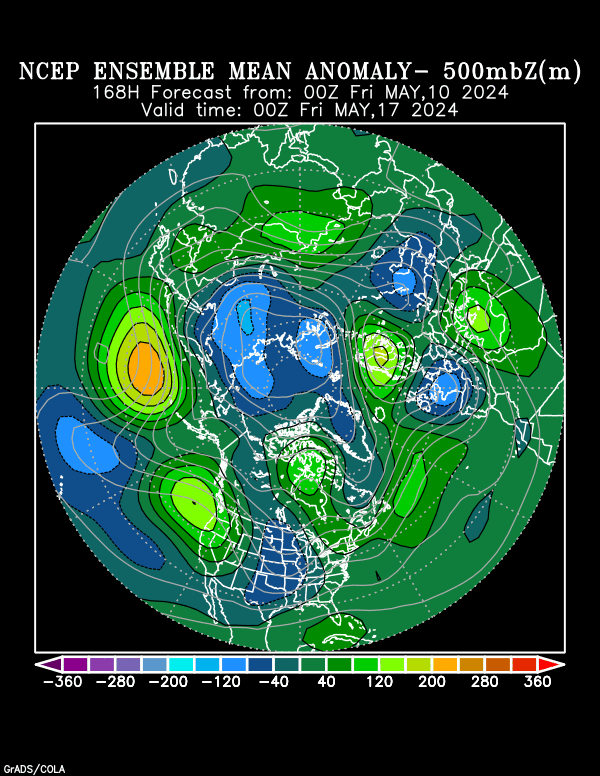
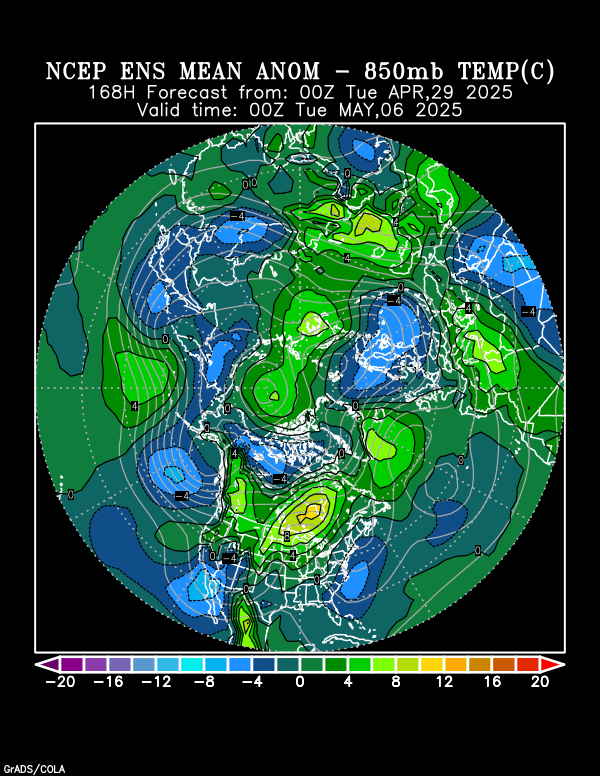
2 weeks out below
++++++++++++++++++++++++
Latest, updated graph/forecast for AO and NAO and PNA here, including an explanation of how to interpret them...............mainly where they stand at the end of 2 weeks
https://www.marketforum.com/forum/t
Previous analysis, with the latest day at the bottom for late week 2 period.
Discussions, starting with the oldest below.
Friday, June 19th: Near 0 for the AO/NAO. However, the PNA is solidly positive. Warm/hot and dry in the West if often a result..........how far east would that be? Is this part of a La Nina signal?
Sunday: AO/NAO slightly negative. PNA solidly positive. Doesn't match that well with the actually weather maps/pattern.
Monday: Negative AO, slight negative NAO but the NAO starts solidly positive and crashes to negative during week 2. Could signal a pattern change.
Wednesday. Nothing noteworthy, especially with this being Summer and these indices work best with the northern stream in the Winter.
THursday: AO near 0. NAO bounces from negative to zero, some positive. PNA goes from positive to negative. SIgn of a pattern change with heat ridge building in the S.Plains to points east/northeastward??? We'll see
Friday: PNA dropping a bit could help pump heat ridge farther east?
Saturday: Indices all near zero towards the end of week 2.
Monday: Not a factor in the pattern, except to allow it to happen with no northern stream influence (huge dome developing in the Southern half of the country.
Tuesday: Data error.
Wednesday: Not a major factor.
Thursday: Slightly negative AO/NAO near 0 PNA. Not a main factor.
Sunday: Solidly negative AO(for Summer) and slightly negative NAO with a lot of spread in solutions introduces a risk of northern stream cooling, especially in the northern tier, despite the models pretty impressive heat ridge/dome over most of the country in week 2. This has the potential to dig some energy into the Northeast and back the dome farther west............POTENTIAL. Tremendous uncertainty and a huge change in the -past 24 hours that featured a version of this, now coming up later this week(that wasn't there before) is noteworthy.
Wednesday: A bit negative for the AO and NAO. PNA goes from positive towards 0 at the end of 2 weeks.
Thursday: Slightly negative AO and NAO. PNA near 0 but an extremely wide spread at the end of 2 weeks tells us the models are in poor agreement in the solution then in the western part of North America.
Friday: -AO, -NAO(bring the risk for cooler air to push farther south into the Midwest) but increasing to 0 at the end of 2 weeks. +PNA decreasing to near 0 at the end of 2 weeks.
Saturday: -AO/-NAO favor less heat than the models predict in the Northern Tier. +PNA drops to near 0 late.
Sunday: Still -AO/-NAO favors less heat northern tier to northern half to Northeast. PNA near 0.
Tuesday: Still the -AO and -NAO favoring less heat northern parts of US to Northeast. PNA a tad positive.
National Weather Service 6-10 day, 8-14 day outlooks.
Updated daily just after 2pm Central.
Temperature Probability
| the 8-14 day outlooks ArchivesAnalogsLines-Only FormatGIS Data | |
Temperature Probability | |
 | |
Previous posts:
By Jim_M - July 6, 2020, 12:18 p.m.
Corn and Beans HAVE to be under some significant stress right now.
++++++++++++++++++++++++++++++++++++++++++++++
By metmike - July 6, 2020, 1:28 p.m.
Actually Jim, not in most of the cornbelt. Probably where you are but most of the belt has pretty good soil moisture and temps have not been that hot until now.
++++++++++++++++++++++++++++++++
Re: Re: Re: Re: Weather Monday
By Jim_M - July 6, 2020, 1:40 p.m.
I've been away from home for the last week, but before I left leaves were rolling in the fields around me in NE Ohio. But even at that, corn looked good. But corn in my area is only about waist high, which is typical. Lots of growing to do.
Jim,
The crop condition report maps show the deterioration in the ECB from lack of rains.
With the OH corn dropping -10% and beans -7%!
+++++++++++++++++++++++++++++++++++++
By mikempt - July 7, 2020, 10:04 a.m.
We got flooded here in Valley Forge,Pa.. The bullseye once again! Six inches of rain in less than an hour! I thought i was in texas!!
+++++++++++++++++++++++++++++++++++++++++++++
By metmike - July 7, 2020, 12:21 p.m.
https://weather.com/news/news/2020-07-06-pennsylvania-philadelphia-flash-floods-water-rescues
https://www.inquirer.com/weather/philadelphia-flood-warning-severe-weather-20200706.html
By metmike - July 8, 2020, 1:43 p.m.
12th warmest June on record for the Corn Belt (production weighted); comparable to what was recorded in 2018 and 2016
By metmike - July 8, 2020, 1:49 p.m.
0.43" below normal on rainfall in June for the Corn Belt (production weighted); comparable to what was recorded in 2017 and 2016
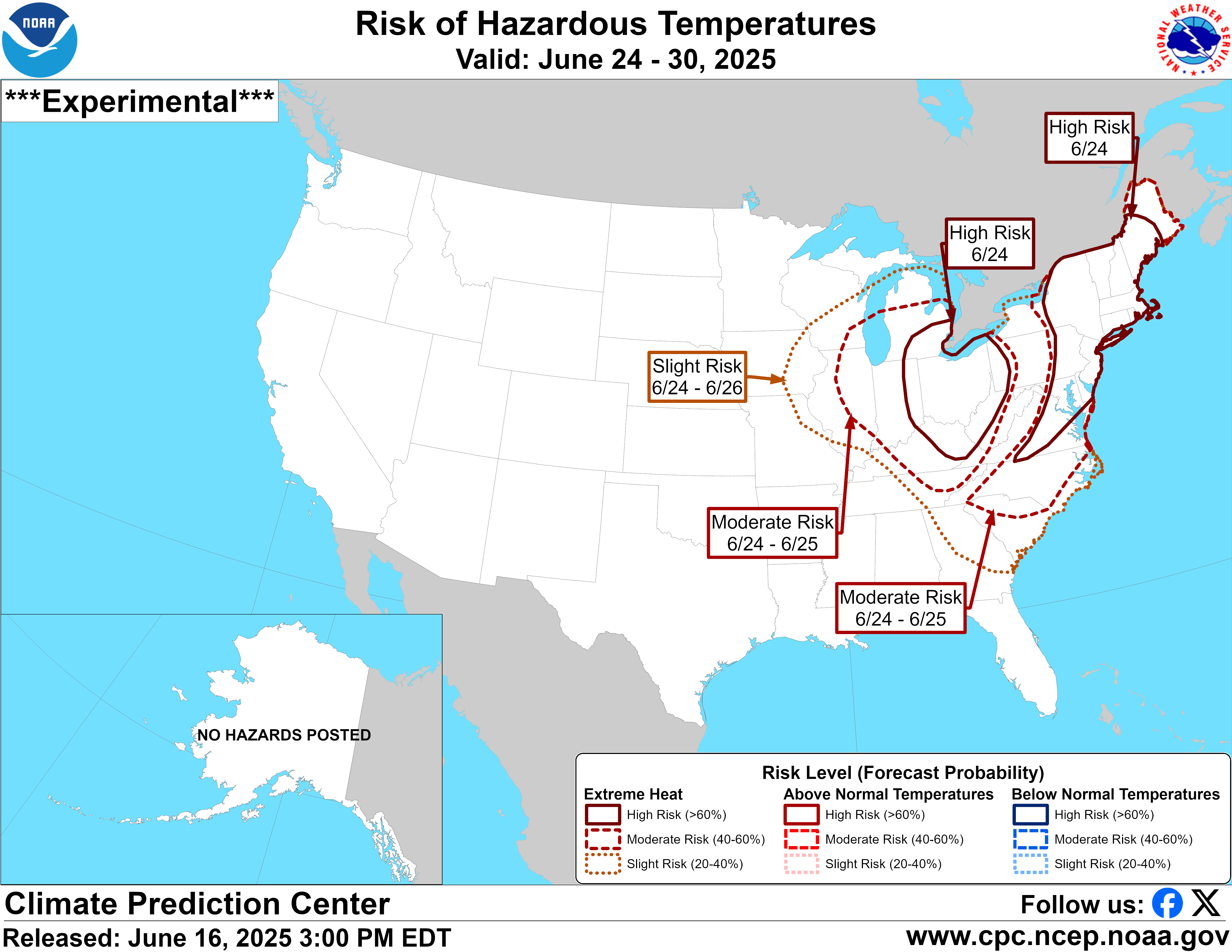
|